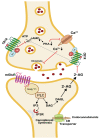Interplay Between Astroglial Endocannabinoid System and the Cognitive Dysfunction in Alzheimer's Disease
- PMID: 38015757
- PMCID: PMC10751057
- DOI: 10.33549/physiolres.935156
Interplay Between Astroglial Endocannabinoid System and the Cognitive Dysfunction in Alzheimer's Disease
Abstract
Cannabinoid CB1 receptors have been shown to regulate wide array of functions ranging from homeostasis to the cognitive functioning but recent data support the hypothesis that astrocytes also operate as a mediator of synaptic plasticity and contribute to cognition and learning. The receptor heterogeneity plays a key role in understanding the molecular mechanisms underlying these processes. Despite the fact that the majority of CB1 receptors act on neurons, studies have revealed that cannabinoids have direct control over astrocytes, including energy generation and neuroprotection. The tripartite synapse connects astrocytes to neurons and allows them to interact with one another and the astrocytes are key players in synaptic plasticity, which is associated with cognitive functions. This review focuses on our growing understanding of the intricate functions of astroglial CB1 that underpin physiological brain function, and in Alzheimer's disease.
Conflict of interest statement
Figures


Similar articles
-
Rising stars: modulation of brain functions by astroglial type-1 cannabinoid receptors.Glia. 2015 Mar;63(3):353-64. doi: 10.1002/glia.22773. Epub 2014 Dec 1. Glia. 2015. PMID: 25452006 Review.
-
Astroglial type-1 cannabinoid receptor (CB1): A new player in the tripartite synapse.Neuroscience. 2016 May 26;323:35-42. doi: 10.1016/j.neuroscience.2015.05.002. Epub 2015 May 9. Neuroscience. 2016. PMID: 25967266 Review.
-
Astrocytes and synaptic plasticity in health and disease.Exp Brain Res. 2017 Jun;235(6):1645-1655. doi: 10.1007/s00221-017-4928-1. Epub 2017 Mar 15. Exp Brain Res. 2017. PMID: 28299411 Review.
-
CB1R-dependent regulation of astrocyte physiology and astrocyte-neuron interactions.Neuropharmacology. 2021 Sep 1;195:108678. doi: 10.1016/j.neuropharm.2021.108678. Epub 2021 Jun 19. Neuropharmacology. 2021. PMID: 34157362 Review.
-
Astrocytes in endocannabinoid signalling.Philos Trans R Soc Lond B Biol Sci. 2014 Oct 19;369(1654):20130599. doi: 10.1098/rstb.2013.0599. Philos Trans R Soc Lond B Biol Sci. 2014. PMID: 25225093 Free PMC article. Review.
Cited by
-
Berberine Exerts Neuroprotective Effects in Alzheimer's Disease by Switching Microglia M1/M2 Polarization Through PI3K-AKT Signaling.Physiol Res. 2025 Mar 24;74(1):129-140. doi: 10.33549/physiolres.935410. Physiol Res. 2025. PMID: 40126149 Free PMC article.
-
Unveiling the Potential of Phytocannabinoids: Exploring Marijuana's Lesser-Known Constituents for Neurological Disorders.Biomolecules. 2024 Oct 13;14(10):1296. doi: 10.3390/biom14101296. Biomolecules. 2024. PMID: 39456229 Free PMC article. Review.
-
The Endocannabinoid System in Retinal Müller Glia: Lessons From Astrocyte Research.Neurochem Res. 2025 Jun 24;50(4):206. doi: 10.1007/s11064-025-04457-0. Neurochem Res. 2025. PMID: 40553186 Review.
